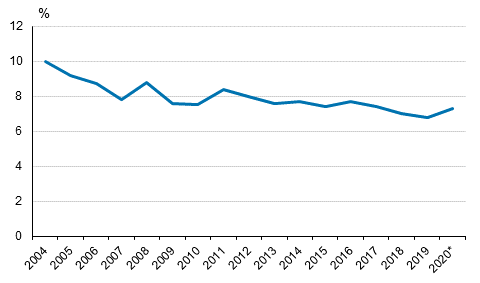Published: 9 February 2021
Number of people at risk of poverty or social exclusion was 873,000 in 2019
Statistics Finland's preliminary data on statistics on living conditions show that 873,000 Finns, or 16.0 per cent of the entire household population were at risk of poverty or social exclusion in 2019. The number of persons at risk grew by around 17,000 from the previous year. The change was primarily due to growth in the numer of low income households.
Share of persons at risk of poverty or social exclusion by sex in 2008 to 2019*

Being at risk of poverty or social exclusion means that the person is living in a low income household, a household with low work intensity or a household that experiences severe material deprivation (see concepts ). One of these risks materialising means that the person is at risk of poverty or social exclusion, but the risks can also be simultaneous. There were 669,000 persons living in low income households, 376,000 persons with low work intensity and 139,000 living in severe material deprivation in 2019.
Most persons at risk of poverty or social exclusion are only members in low income households. They numbered 425,000 persons or 7.8 per cent of the population and slightly under one-half of all persons at risk of poverty or social exclusion. The second most common situation was to experience both low income and low work intensity, which affects around 182,000 persons or 3.3 per cent of the population. Mere low work intensity is the third most common, and that concerned approximately 127,000 persons, or 2.3 per cent of the population.
Women’s risk of poverty or social exclusion diminished and men's grew in 2019. In all, 15.9 per cent of women or 438,000 persons and 16.2 per cent of men or 435,000 were at risk of poverty or social exclusion in 2019 (Figure). In the long term, the difference between women and men has narrowed especially due to the contraction of differences in low income among the oldest women and men. Experiences of low work intensity were somewhat more common among men (7.6%) than women (6.3%). Men also experience slightly more often than women a risk in more than one risk factor.
Living in low income households, low work intensity and severe material deprivation are all household-specific indicators. Thus observed gender differences in being at risk of poverty or social exclusion or its components mostly derive from differences between people living alone.
Of men at risk 65 per cent were of working age and only 15 per cent pensioners, while around 58 per cent of women at risk were of working age and 26 per cent pensioners. The lower number of female pensioners living in low income households has narrowed down the differences between women and men at risk of poverty or social exclusion compared to 2008, when 18 per cent of women and 15.8 per cent of men were at risk of poverty or social exclusion. – More information on differences between population groups at risk of poverty or social exclusion is available in the database tables of the statistics on living conditions and in more detail in the income distribution statistics .
The so-called AROPE indicator (At Risk of Poverty or Social Exclusion) that measures the risk of poverty or social exclusion is part of the monitoring of the objectives of the Europe 2020 Strategy. It aims to reduce the number of persons living at risk of poverty or social exclusion in the EU by 20 million by 2020 compared with 2008, when there were 116 million people at risk of poverty or social exclusion. In 2018, altogether 108 million persons were at risk in 28 EU countries.
Households’ difficulties in making ends meet became slightly more general in 2020
In 2020, there were slightly more households experiencing difficulties in making ends meet than in the year before 1) . In all, 7.3 per cent of households had difficulties or great difficulties in making ends meet, while in the previous year, the share was 6.8 per cent (Figure). The share of households experiencing difficulties in making ends meet has been under eight per cent throughout the 2010s except for 2011 2) .
In addition, around 72 per cent of households said that they could face unexpected expenses without outside help. The best prepared were pensioner households of two adults around 91 per cent of whom could face unexpected expenses. The least prepared were one-supporter households (around 47%) and young one-person households (about 56%). Unexpected expenses refer to the sum corresponding to the monthly at-risk-of-poverty threshold for a one-person household, which in recent years has been around EUR 1,200.
Share of households with difficulties or great difficulties in making ends meet in 2004 to 2020*, %

1) Data are published in the statistics on living conditions according to two reference periods. The reference period for the risk of poverty or social exclusion is the year of income earning, but data based on interviews describe the time of the interview, that is, the year after the year of income earning. Further information on reference times is available in the quality description of this publication.
2) The interview data were collected for the survey between January and June 2020. Because the corona pandemic and the restrictive measures that followed from it entered into force midway through the data collection, the data collected in the interview reflect only partially any changes possibly caused by the pandemic, for example, in economic livelihood.
Source: Statistics on living conditions 2020, Statistics Finland
Inquiries: Kaisa-Mari Okkonen 029 551 3408
Head of Department in charge: Hannele Orjala
- Tables
-
Tables in databases
Pick the data you need into tables, view the data as graphs, or download the data for your use.
Updated 09.02.2021
Official Statistics of Finland (OSF):
Statistics on living conditions [e-publication].
01 2020. Helsinki: Statistics Finland [referred: 3.4.2025].
Access method: http://stat.fi/til/eot/2020/01/eot_2020_01_2021-02-09_tie_001_en.html

